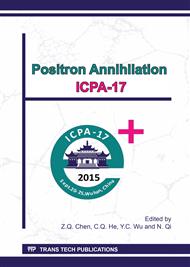p.35
p.41
p.46
p.53
p.57
p.61
p.65
p.71
p.75
Project for a Source of Polarized Slow Positrons at ELI-NP
Abstract:
We describe the status of a project for obtaining an intense beam of polarized slow positrons at the Extreme Light Infrastructure - Nuclear Physics (ELI-NP) at Magurele (near Bucharest, Romania) [1]. Positrons will be created via pair production and moderated at a tungsten target using the pulsed brilliant gamma beam which will be produced by Compton back-scattering of circularly polarized laser photons on electrons from a warm linac beam [2]. Simulations of the interaction of circularly polarized γ‑rays of energies up to 3.5 MeV and an intensity of 2.4×1010 γ/s with the target, moderation of created positrons and beam formation are discussed. The optimization of the target design showed that the primary slow positron beam can be obtained with intensity of 1‑2×106 e+/s. The primary beam will be transversally polarized with a degree of polarization of ~30%. We discuss the necessity of changing the e+ beam polarization from transversal to longitudinal by an electrostatic 90˚ bender which is proposed to work in combination with a remoderator. Simulations show that neither the remoderator nor the electrostatic bender will change the degree of e+ beam polarization. The longitudinally polarized e+ can be successfully transported to the sample chambers without depolarization, but with reduced intensity (by approximately one order of magnitude) due to the remoderation. We present a convertor-moderator assembly with a hole which will allow creating positrons in parasitic mode, i.e., simultaneously with the nuclear physics experiments at ELI-NP. The positron spectroscopy laboratory at ELI-NP will be user dedicated and the beam will have the highest intensity of polarized slow positrons for material science in the world and therefore it could become a unique tool for investigation of magnetic samples.
Info:
Periodical:
Pages:
57-60
Citation:
Online since:
March 2017
Authors:
Keywords:
Price:
Сopyright:
© 2016 Trans Tech Publications Ltd. All Rights Reserved
Share:
Citation:


